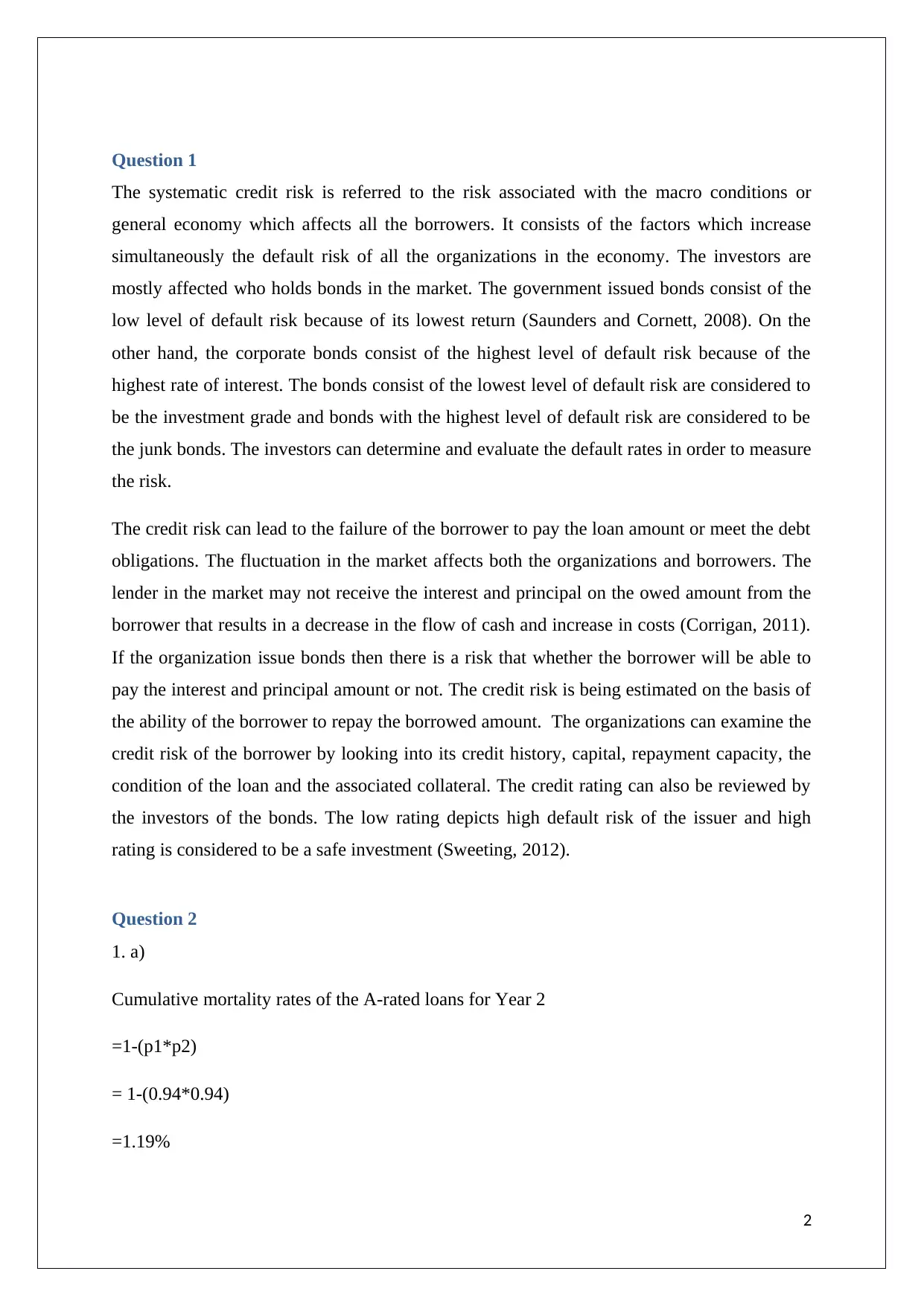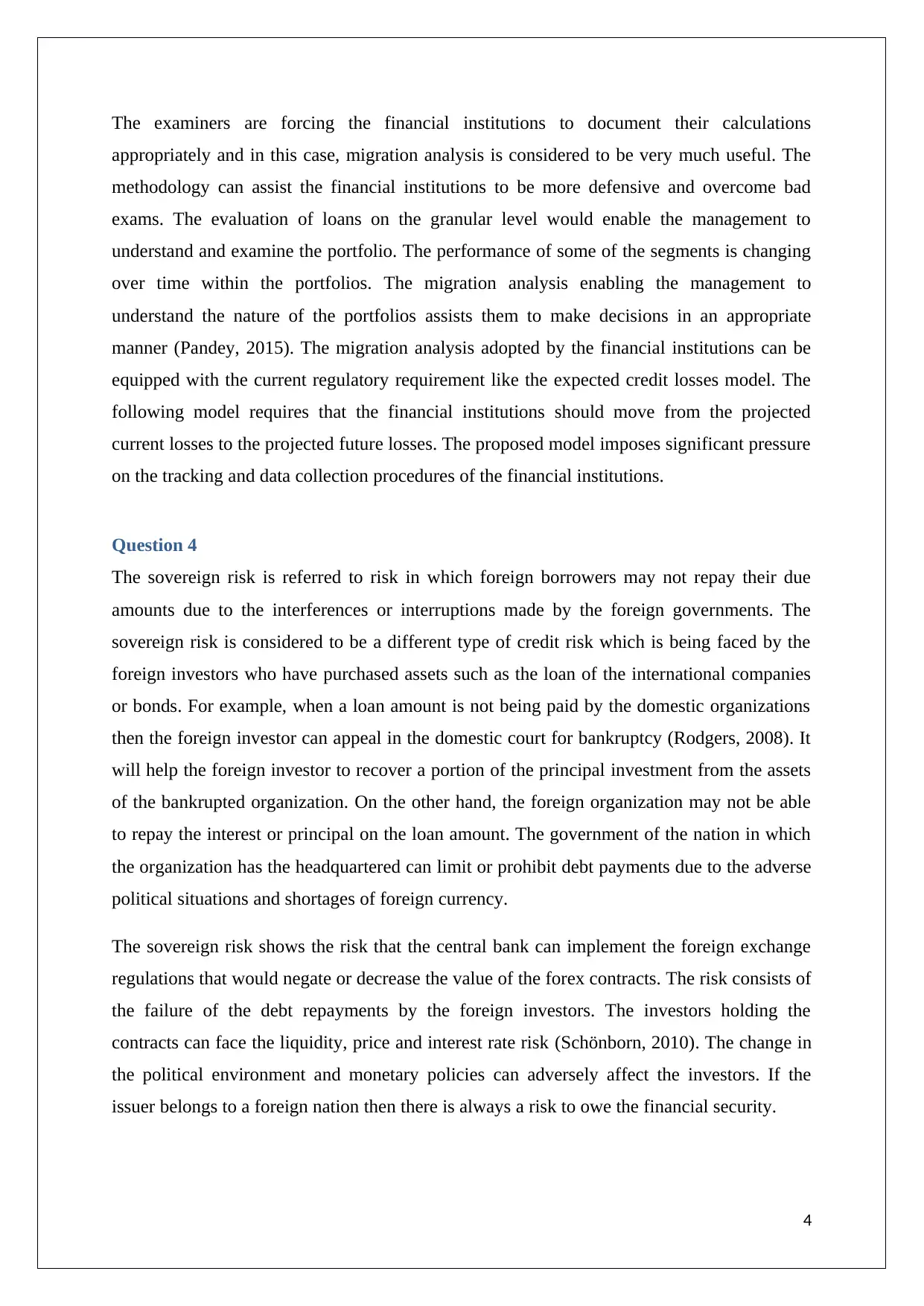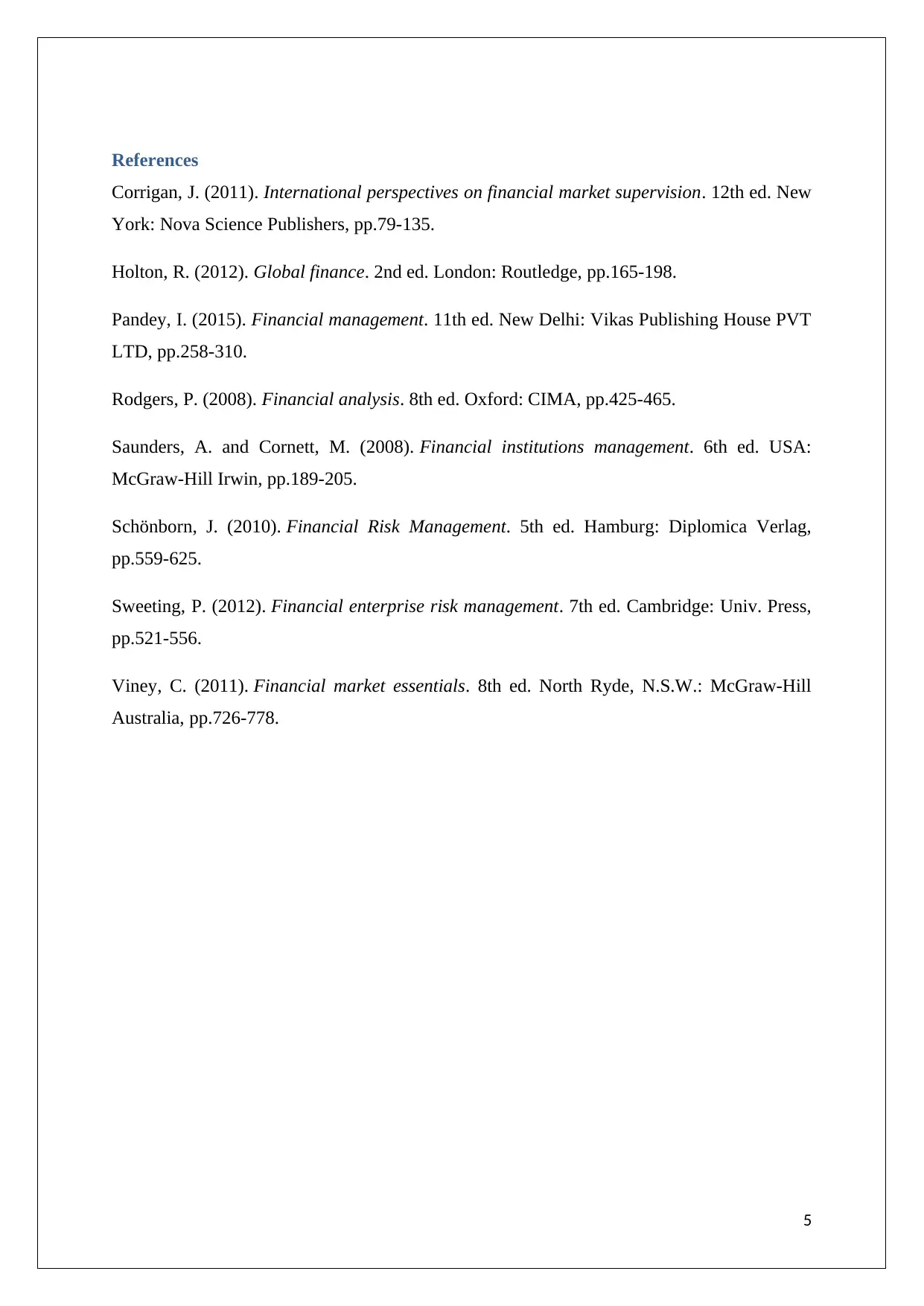Bank Financial Risk Management: Credit Risk Analysis - BK7019 Report
VerifiedAdded on 2023/05/30
|6
|1312
|91
Report
AI Summary
This report delves into various aspects of credit risk within the context of bank financial risk management (BK7019). It explains systematic credit risk, focusing on its impact on borrowers and investors, and discusses methods for evaluating default rates and creditworthiness. The report includes calculations of cumulative and yearly mortality rates for A-rated and B-rated loans. It further examines the use of migration analysis in identifying credit risk in sectoral loans, highlighting its benefits for financial institutions in adjusting risk ratings and meeting regulatory requirements. Finally, the report addresses sovereign risk, explaining how foreign government interventions can affect debt repayments and the risks faced by foreign investors. Desklib offers a range of resources, including past papers and solved assignments, to support students in mastering these concepts.

Bank Financial Risk Management
Paraphrase This Document
Need a fresh take? Get an instant paraphrase of this document with our AI Paraphraser

Table of Contents
Question 1..................................................................................................................................2
Question 2..................................................................................................................................2
Question 3..................................................................................................................................3
Question 4..................................................................................................................................3
References..................................................................................................................................5
1
Question 1..................................................................................................................................2
Question 2..................................................................................................................................2
Question 3..................................................................................................................................3
Question 4..................................................................................................................................3
References..................................................................................................................................5
1

Question 1
The systematic credit risk is referred to the risk associated with the macro conditions or
general economy which affects all the borrowers. It consists of the factors which increase
simultaneously the default risk of all the organizations in the economy. The investors are
mostly affected who holds bonds in the market. The government issued bonds consist of the
low level of default risk because of its lowest return (Saunders and Cornett, 2008). On the
other hand, the corporate bonds consist of the highest level of default risk because of the
highest rate of interest. The bonds consist of the lowest level of default risk are considered to
be the investment grade and bonds with the highest level of default risk are considered to be
the junk bonds. The investors can determine and evaluate the default rates in order to measure
the risk.
The credit risk can lead to the failure of the borrower to pay the loan amount or meet the debt
obligations. The fluctuation in the market affects both the organizations and borrowers. The
lender in the market may not receive the interest and principal on the owed amount from the
borrower that results in a decrease in the flow of cash and increase in costs (Corrigan, 2011).
If the organization issue bonds then there is a risk that whether the borrower will be able to
pay the interest and principal amount or not. The credit risk is being estimated on the basis of
the ability of the borrower to repay the borrowed amount. The organizations can examine the
credit risk of the borrower by looking into its credit history, capital, repayment capacity, the
condition of the loan and the associated collateral. The credit rating can also be reviewed by
the investors of the bonds. The low rating depicts high default risk of the issuer and high
rating is considered to be a safe investment (Sweeting, 2012).
Question 2
1. a)
Cumulative mortality rates of the A-rated loans for Year 2
=1-(p1*p2)
= 1-(0.94*0.94)
=1.19%
2
The systematic credit risk is referred to the risk associated with the macro conditions or
general economy which affects all the borrowers. It consists of the factors which increase
simultaneously the default risk of all the organizations in the economy. The investors are
mostly affected who holds bonds in the market. The government issued bonds consist of the
low level of default risk because of its lowest return (Saunders and Cornett, 2008). On the
other hand, the corporate bonds consist of the highest level of default risk because of the
highest rate of interest. The bonds consist of the lowest level of default risk are considered to
be the investment grade and bonds with the highest level of default risk are considered to be
the junk bonds. The investors can determine and evaluate the default rates in order to measure
the risk.
The credit risk can lead to the failure of the borrower to pay the loan amount or meet the debt
obligations. The fluctuation in the market affects both the organizations and borrowers. The
lender in the market may not receive the interest and principal on the owed amount from the
borrower that results in a decrease in the flow of cash and increase in costs (Corrigan, 2011).
If the organization issue bonds then there is a risk that whether the borrower will be able to
pay the interest and principal amount or not. The credit risk is being estimated on the basis of
the ability of the borrower to repay the borrowed amount. The organizations can examine the
credit risk of the borrower by looking into its credit history, capital, repayment capacity, the
condition of the loan and the associated collateral. The credit rating can also be reviewed by
the investors of the bonds. The low rating depicts high default risk of the issuer and high
rating is considered to be a safe investment (Sweeting, 2012).
Question 2
1. a)
Cumulative mortality rates of the A-rated loans for Year 2
=1-(p1*p2)
= 1-(0.94*0.94)
=1.19%
2
⊘ This is a preview!⊘
Do you want full access?
Subscribe today to unlock all pages.

Trusted by 1+ million students worldwide

Cumulative mortality rates of the B-rated loans for Year 2
=1-(p1*p2)
= 1-(0.99*0.986)
=2.38%
2. b)
Yearly mortality rate in Year 3 for the B-rated loan
=1-(p1*p2*p3)=0.0376
= 1-(0.99*0.986*p3)=0.0376
=>p3=0.9624/0.9761
= 0.9859
Yearly rate = 1-0.9859
= 0.14035*100
Yearly rate = 1.40%
Question 3
The information is being used by migration analysis to identify the credit risk of sectoral
loans or an individual loan. For example, the financial institutions can use Moody's ratings
and S&P for determining whether organizations are experiencing problems in repaying owed
amounts. The information can be used to decrease maturity or restrict lending that particular
sector or increase the rate of interest (Holton, 2012). The adoption of the migration analysis is
considered to be difficult for many financial institutions but it can provide significant
information which is considered to be very much useful. The loan segments can be evaluated
at the given level of risk rating. The analysis of migration of the loans through a period of
time enables the management to understand the performance of the loans in each segment and
estimating the rate of loss. The migration analysis encourages the financial institutions to
adjust and track the changes in the risk rating appropriately in its loan portfolio. The
adjustments in the market risk rating in an appropriate manner are significant for appropriate
implementation of the migration analysis (Viney, 2011).
3
=1-(p1*p2)
= 1-(0.99*0.986)
=2.38%
2. b)
Yearly mortality rate in Year 3 for the B-rated loan
=1-(p1*p2*p3)=0.0376
= 1-(0.99*0.986*p3)=0.0376
=>p3=0.9624/0.9761
= 0.9859
Yearly rate = 1-0.9859
= 0.14035*100
Yearly rate = 1.40%
Question 3
The information is being used by migration analysis to identify the credit risk of sectoral
loans or an individual loan. For example, the financial institutions can use Moody's ratings
and S&P for determining whether organizations are experiencing problems in repaying owed
amounts. The information can be used to decrease maturity or restrict lending that particular
sector or increase the rate of interest (Holton, 2012). The adoption of the migration analysis is
considered to be difficult for many financial institutions but it can provide significant
information which is considered to be very much useful. The loan segments can be evaluated
at the given level of risk rating. The analysis of migration of the loans through a period of
time enables the management to understand the performance of the loans in each segment and
estimating the rate of loss. The migration analysis encourages the financial institutions to
adjust and track the changes in the risk rating appropriately in its loan portfolio. The
adjustments in the market risk rating in an appropriate manner are significant for appropriate
implementation of the migration analysis (Viney, 2011).
3
Paraphrase This Document
Need a fresh take? Get an instant paraphrase of this document with our AI Paraphraser

The examiners are forcing the financial institutions to document their calculations
appropriately and in this case, migration analysis is considered to be very much useful. The
methodology can assist the financial institutions to be more defensive and overcome bad
exams. The evaluation of loans on the granular level would enable the management to
understand and examine the portfolio. The performance of some of the segments is changing
over time within the portfolios. The migration analysis enabling the management to
understand the nature of the portfolios assists them to make decisions in an appropriate
manner (Pandey, 2015). The migration analysis adopted by the financial institutions can be
equipped with the current regulatory requirement like the expected credit losses model. The
following model requires that the financial institutions should move from the projected
current losses to the projected future losses. The proposed model imposes significant pressure
on the tracking and data collection procedures of the financial institutions.
Question 4
The sovereign risk is referred to risk in which foreign borrowers may not repay their due
amounts due to the interferences or interruptions made by the foreign governments. The
sovereign risk is considered to be a different type of credit risk which is being faced by the
foreign investors who have purchased assets such as the loan of the international companies
or bonds. For example, when a loan amount is not being paid by the domestic organizations
then the foreign investor can appeal in the domestic court for bankruptcy (Rodgers, 2008). It
will help the foreign investor to recover a portion of the principal investment from the assets
of the bankrupted organization. On the other hand, the foreign organization may not be able
to repay the interest or principal on the loan amount. The government of the nation in which
the organization has the headquartered can limit or prohibit debt payments due to the adverse
political situations and shortages of foreign currency.
The sovereign risk shows the risk that the central bank can implement the foreign exchange
regulations that would negate or decrease the value of the forex contracts. The risk consists of
the failure of the debt repayments by the foreign investors. The investors holding the
contracts can face the liquidity, price and interest rate risk (Schönborn, 2010) . The change in
the political environment and monetary policies can adversely affect the investors. If the
issuer belongs to a foreign nation then there is always a risk to owe the financial security.
4
appropriately and in this case, migration analysis is considered to be very much useful. The
methodology can assist the financial institutions to be more defensive and overcome bad
exams. The evaluation of loans on the granular level would enable the management to
understand and examine the portfolio. The performance of some of the segments is changing
over time within the portfolios. The migration analysis enabling the management to
understand the nature of the portfolios assists them to make decisions in an appropriate
manner (Pandey, 2015). The migration analysis adopted by the financial institutions can be
equipped with the current regulatory requirement like the expected credit losses model. The
following model requires that the financial institutions should move from the projected
current losses to the projected future losses. The proposed model imposes significant pressure
on the tracking and data collection procedures of the financial institutions.
Question 4
The sovereign risk is referred to risk in which foreign borrowers may not repay their due
amounts due to the interferences or interruptions made by the foreign governments. The
sovereign risk is considered to be a different type of credit risk which is being faced by the
foreign investors who have purchased assets such as the loan of the international companies
or bonds. For example, when a loan amount is not being paid by the domestic organizations
then the foreign investor can appeal in the domestic court for bankruptcy (Rodgers, 2008). It
will help the foreign investor to recover a portion of the principal investment from the assets
of the bankrupted organization. On the other hand, the foreign organization may not be able
to repay the interest or principal on the loan amount. The government of the nation in which
the organization has the headquartered can limit or prohibit debt payments due to the adverse
political situations and shortages of foreign currency.
The sovereign risk shows the risk that the central bank can implement the foreign exchange
regulations that would negate or decrease the value of the forex contracts. The risk consists of
the failure of the debt repayments by the foreign investors. The investors holding the
contracts can face the liquidity, price and interest rate risk (Schönborn, 2010) . The change in
the political environment and monetary policies can adversely affect the investors. If the
issuer belongs to a foreign nation then there is always a risk to owe the financial security.
4

References
Corrigan, J. (2011). International perspectives on financial market supervision. 12th ed. New
York: Nova Science Publishers, pp.79-135.
Holton, R. (2012). Global finance. 2nd ed. London: Routledge, pp.165-198.
Pandey, I. (2015). Financial management. 11th ed. New Delhi: Vikas Publishing House PVT
LTD, pp.258-310.
Rodgers, P. (2008). Financial analysis. 8th ed. Oxford: CIMA, pp.425-465.
Saunders, A. and Cornett, M. (2008). Financial institutions management. 6th ed. USA:
McGraw-Hill Irwin, pp.189-205.
Schönborn, J. (2010). Financial Risk Management. 5th ed. Hamburg: Diplomica Verlag,
pp.559-625.
Sweeting, P. (2012). Financial enterprise risk management. 7th ed. Cambridge: Univ. Press,
pp.521-556.
Viney, C. (2011). Financial market essentials. 8th ed. North Ryde, N.S.W.: McGraw-Hill
Australia, pp.726-778.
5
Corrigan, J. (2011). International perspectives on financial market supervision. 12th ed. New
York: Nova Science Publishers, pp.79-135.
Holton, R. (2012). Global finance. 2nd ed. London: Routledge, pp.165-198.
Pandey, I. (2015). Financial management. 11th ed. New Delhi: Vikas Publishing House PVT
LTD, pp.258-310.
Rodgers, P. (2008). Financial analysis. 8th ed. Oxford: CIMA, pp.425-465.
Saunders, A. and Cornett, M. (2008). Financial institutions management. 6th ed. USA:
McGraw-Hill Irwin, pp.189-205.
Schönborn, J. (2010). Financial Risk Management. 5th ed. Hamburg: Diplomica Verlag,
pp.559-625.
Sweeting, P. (2012). Financial enterprise risk management. 7th ed. Cambridge: Univ. Press,
pp.521-556.
Viney, C. (2011). Financial market essentials. 8th ed. North Ryde, N.S.W.: McGraw-Hill
Australia, pp.726-778.
5
⊘ This is a preview!⊘
Do you want full access?
Subscribe today to unlock all pages.

Trusted by 1+ million students worldwide
1 out of 6
Your All-in-One AI-Powered Toolkit for Academic Success.
+13062052269
info@desklib.com
Available 24*7 on WhatsApp / Email
![[object Object]](/_next/static/media/star-bottom.7253800d.svg)
Unlock your academic potential
Copyright © 2020–2025 A2Z Services. All Rights Reserved. Developed and managed by ZUCOL.